| Home | Revision | GCSE | Biology | Movement In And Out Of Cells |
Movement In And Out Of Cells
Substance move in and out of cells by three ways:
- Diffusion: The net movement of particles from a region of their higher concentration to a region of their lower concentration down a concentration gradient, as a result of random movement.
- Osmosis: The diffusion of water molecules from a region of their higher concentration (dilute solution) to a region of their lower concentration (concentrated solution) through a partially permeable membrane.
- Active Transport: The movement of ions, in and out of a cell, through a cell membrane, from a region of their lower concentration to a region of their higher concentration, against the concentration gradient, using the energy released by respiration.
Diffusion:
Diffusion is the process by which oxygen enters the blood from the lungs, and by which carbon dioxide enters the leaf from the atmosphere. There are many more examples of diffusion in biology.
Diffusion always takes place down a concentration gradient, that means that the particles that diffuse try to spread evenly in all spaces, so it moves from where it’s very concentrated to where it’s not concentrated.
There are some factors affecting the rate of diffusion, like the steepness of the concentration gradient. The steeper the gradient the faster the particles diffuse.
The surface area of the exchange membrane also affects the rate of diffusion. The larger the surface area of the exchange membrane the faster particles diffuse.
Thickness of exchange membrane too determines the diffusion rate, the thinner it is, the easier it will be for particles to go through it, the faster the diffusion rate.
Temperature is another factor affecting the diffusion rate, increasing the temperature will give particles more kinetic energy, making them move faster, thus increasing the rate of diffusion.
Osmosis:
Osmosis is the diffusion of water molecules. When we speak about osmosis, we don’t say water concentration; instead we use the term water potential. A dilute solution means it has lots of water molecules, and a high water potential. A concentrated solution has few water molecules and low water potential. Osmosis has to take place through a partially permeable membrane (or Semipermeable) this means that the Water molecules move from a place of their high concentration to a place of their low concentration through a membrane with pores in it that lets some molecules through but not others.

The diagram shows two solutions, one dilute and one concentrated, separated by a semipermeable membrane. The solution on the right is diluted while the concentration on the left is concentrated. The water molecules will move from the right handside solution where they are very concentrated to the left handside solution where they are of a very low concentration, osmosis took place.
| Osmosis happens all the time in cells. If you place an animal cell in distilled water. Osmosis will result in the water molecules moving from the distilled water where they are very concentrated to the Cell Where they are of low concentration Through the cell surface membrane. The cell becomes fat. As more Water molecules enter the cell, the cell will eventually burst and die. | 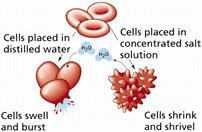 |
If we do the opposite, and place a red blood cell in a concentrated salt solution, the water in the cell has a higher water potential that the concentrated salt solution. Water molecules will move from the cell to the salt solution causing the cell to become shrunken and shrivel as in the diagram.
| Hypotonic Solution | Isotonic Solution | Hypertonic Solution | |
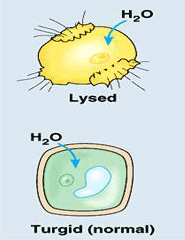 |
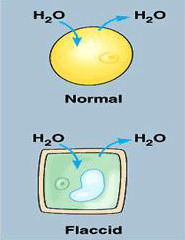 |
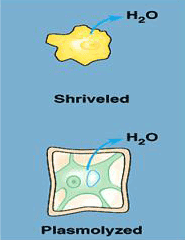 |
Animal Cell |
| Plant Cell |
In plant cells, if a plant cell is placed in distilled water, water molecules will move from the distilled water to the cell, the cell swells up and becomes turgid but it will never burst because plant cells are surrounded by cell walls, which are made of cellulose and is elastic, it will stretch but never break, the cell becomes turgid.
If we place a plant cell in a concentrated salt solution whith low water potential, water will move from the cell to the solution causing the cell to become plasmolysed as in the diagram.
Active Transport:
Active transport occurs in cells, it is basically the movement of molecules or ions from a region of their low concentration to a region of their high concentration (against the concentration gradient) using energy of respiration. Active transport occurs in living, active cells only because it needs energy, these cells usually have a structure called mitochondria which respires producing energy to be used in active transport.
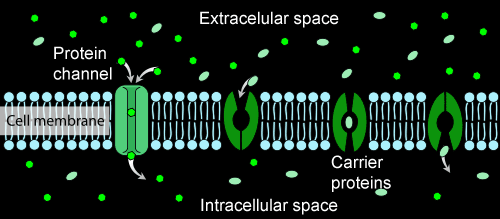
Active transport happens in roots to absorb mineral salts from the soil. It also occurs in the digestive system of mammals.
If oxygen is absent, respiration won’t take place, active transport will stop. Molecules are taken into the cell by protein carriers within the cell membrane.